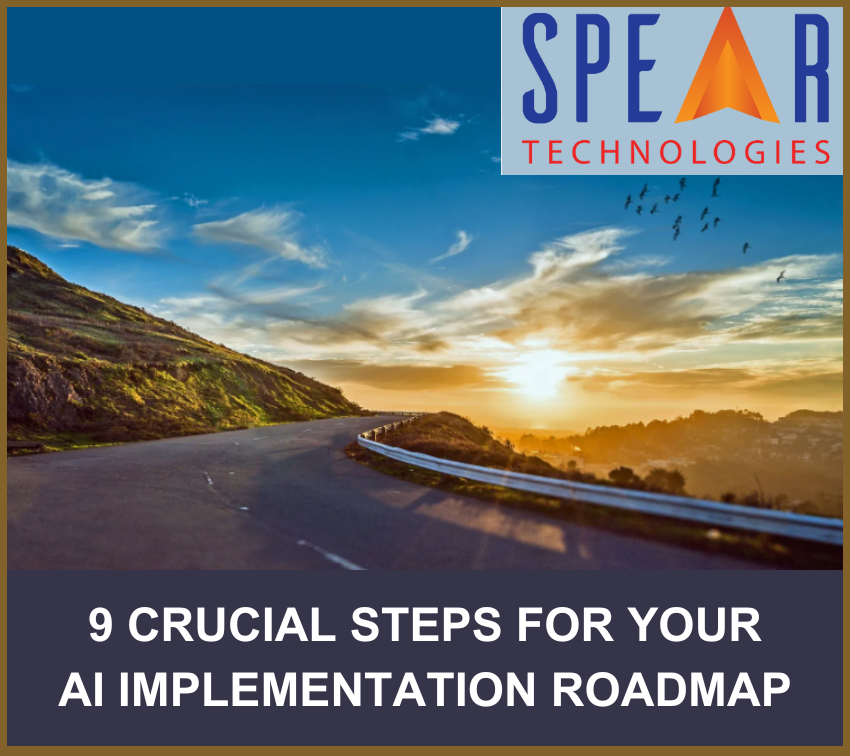9 Crucial Steps for Your AI Implementation Roadmap

Artificial Intelligence (AI) is transforming the insurance industry, offering solutions to long-standing challenges in underwriting, claims processing, fraud detection, and customer engagement. However, implementing AI in a way that delivers sustainable value requires a structured approach. This blog outlines an AI Implementation Roadmap tailored for insurance companies, helping them navigate the journey from strategy to execution.
Step 1: Define Strategic Objectives
AI implementation should align with your business goals and address specific pain points. Begin by identifying the areas where AI can have the most impact. Common objectives for insurers include:
- Enhancing operational efficiency through automation.
- Improving risk assessment and underwriting accuracy.
- Detecting and preventing fraud more effectively.
- Personalizing customer experiences with AI-driven insights.
- Reducing claims processing time with intelligent automation.
Prioritize projects based on their potential return on investment (ROI) and feasibility.
Step 2: Understand the different types of AI Models
Not all AI models are equal; insurers must evaluate solutions for specific needs. Specialized tools excel in niche areas like fraud detection but may require costly integrations, while core systems often lack depth. To maximize AI’s potential, focus on models delivering tangible benefits in underwriting, claims, customer service, and fraud prevention.
- 7 AI Models and Their Roles
- Generative AI: Models such as ChatGPT for creating content.
- Predictive Analytics: Predicts future trends based on historical data.
- Natural Language Processing: Interprets and generates human language.
- Machine Learning: Learns from data to improve predictions and decision-making over time.
- Robotics and Autonomous Processing: Reduces human involvement in repetitive tasks.
- Expert Systems: Replicates the decision-making abilities of human experts.
- Cognitive Computing: Mimics human thought processes, combining NLP, ML, and contextual awareness to offer deep insights.
- To read an in-depth description of each of the 7 types of AI, along with use cases:
Step 3: Assess Readiness
A readiness assessment ensures that your organization is prepared for AI adoption. This includes evaluating:
- Data Infrastructure: Is your data structured, centralized, and accessible?
- Technical Expertise: Do you have in-house AI expertise, or will you need to rely on external vendors?
- Change Management Capability: Is your organization prepared to adapt workflows and train employees on new tools?
- Regulatory Compliance: Ensure compliance with insurance regulations and data privacy laws like GDPR or HIPAA.
Step 4: Build a Cross-Functional Team
AI implementation requires collaboration across departments. Form a team that includes:
- Data Scientists and Analysts to develop and fine-tune AI models.
- IT Professionals to ensure integration with existing systems.
- Business Stakeholders to define goals and measure outcomes.
- Legal and Compliance Experts to navigate regulatory requirements.
This team will serve as the backbone for planning and executing the AI project.
Step 5: Develop a Pilot Program
Before a full-scale rollout, launch a pilot program to test the AI solution in a controlled environment.
- Select a Use Case: Choose a high-impact, low-risk area, such as automating routine claims processing or fraud detection.
- Define Metrics: Establish clear KPIs, such as time savings, cost reductions, or increased detection rates.
- Gather Feedback: Use insights from the pilot to refine the AI model and address any integration challenges.
Pilots provide valuable insights while minimizing risks.
Step 6: Focus on Data Quality and Management
AI solutions are only as effective as the data they are trained on. Invest in:
- Data Cleaning and Preparation: Eliminate inconsistencies and duplicates.
- Data Enrichment: Combine internal data with external sources for a broader context (e.g., market trends, geographic data).
- Continuous Updates: Keep the data pipeline updated to ensure AI models remain relevant.
Strong data governance is crucial for long-term success.
Step 7: Implement and Scale
Once the pilot demonstrates success, roll out the AI solution across your organization.
- Adopt a Phased Approach: Gradually scale up to minimize disruption.
- Train Employees: Provide training to help employees adapt to AI-enhanced workflows.
- Monitor Performance: Regularly review KPIs to ensure the solution is meeting expectations.
Continuous monitoring ensures scalability and long-term impact.
Step 8: Ensure Regulatory and Ethical Compliance
AI in insurance must operate within a robust ethical and legal framework.
- Explainability: Ensure models provide transparent insights, especially in underwriting and claims decisions.
- Bias Mitigation: Regularly audit algorithms for potential biases.
- Audit Trails: Maintain detailed records for regulatory reviews.
Proactive compliance builds trust with customers and regulators alike.
Step 9: Optimize and Evolve
AI is not a set-it-and-forget-it solution. Regularly refine and improve your AI capabilities by:
- Incorporating New Technologies: Stay updated with advancements in AI tools and methodologies.
- Revisiting Business Goals: Ensure your AI strategy evolves with changing business needs.
- Analyzing Trends: Monitor industry trends to maintain a competitive edge.
Conclusion
An effective AI implementation roadmap can help insurance companies modernize their operations, deliver better customer experiences, and stay competitive in a rapidly evolving market. By following a structured approach, starting with strategic goal setting and ending with continuous optimization, you can ensure that your AI investments yield tangible, long-term results.
AI is no longer a “nice-to-have” but a strategic imperative for insurers. The time to act is now.
To see first-hand how your organization can become faster, more accurate and more customer-friendly with SpearSuite™, our full range of award-winning P&C insurance software solutions including claims management, policy administration, and portal solutions built by industry experts on a modern low code platform that delivers the power of built-in AI and Analytics while lowering your total cost of ownership, Schedule a Demo.
To discover how Spear’s solutions are accessible to insurers of all sizes, Request Pricing.



